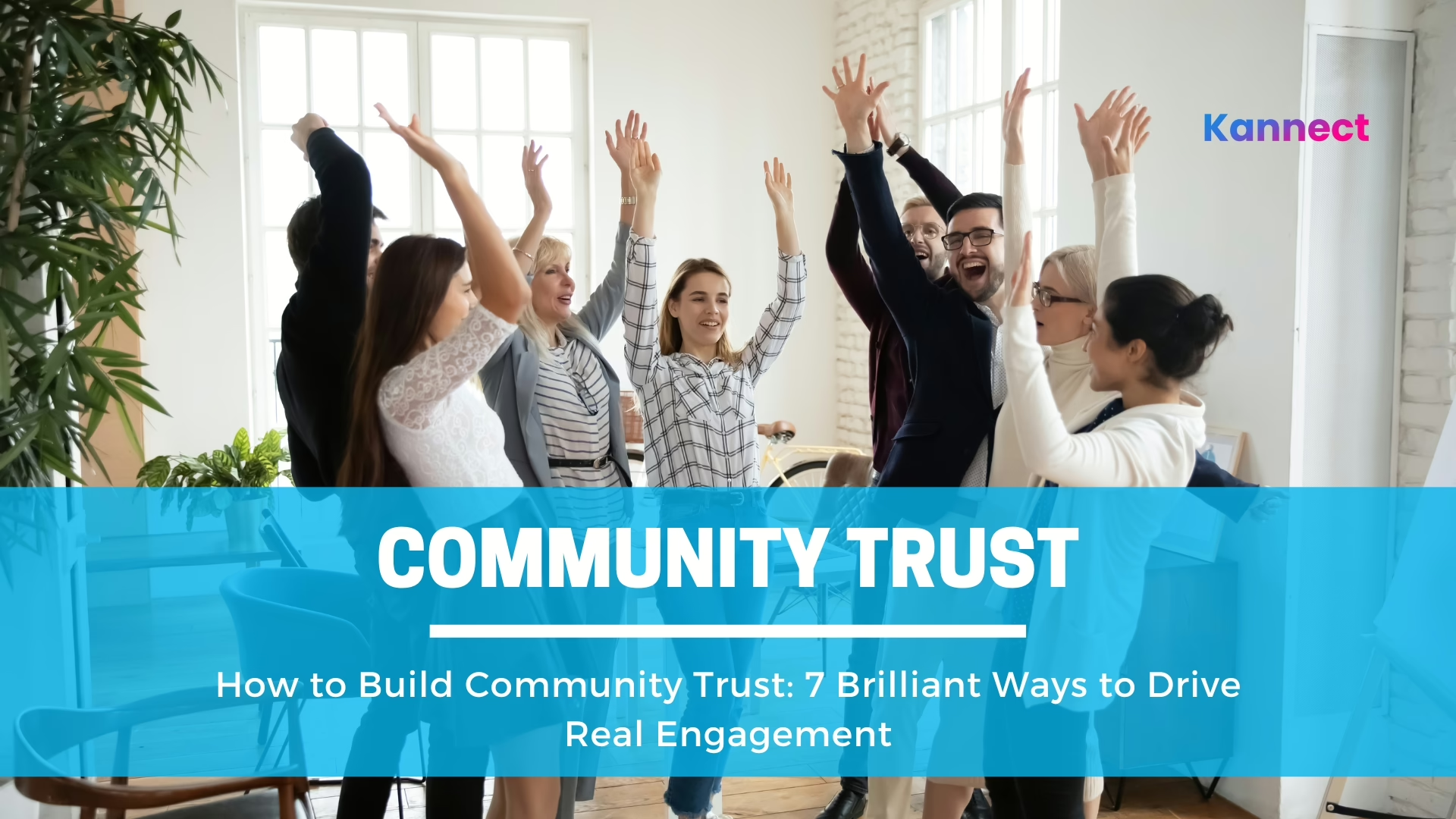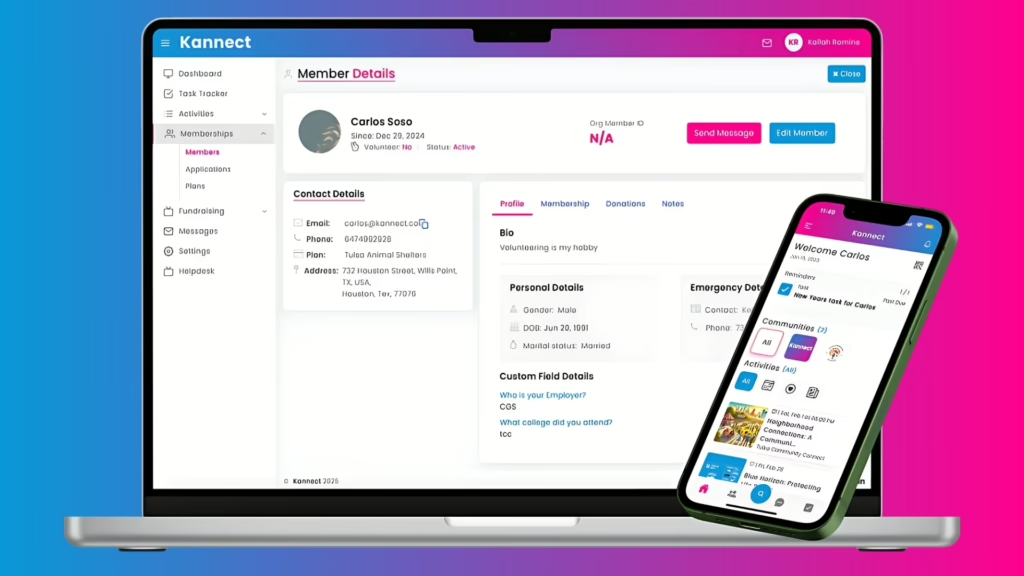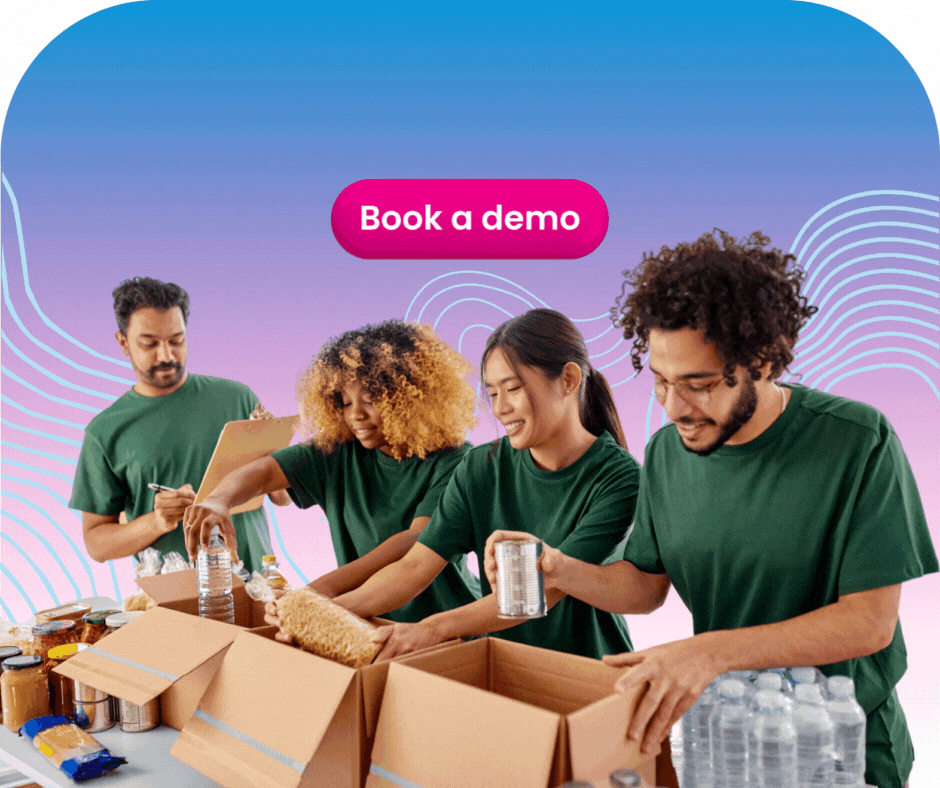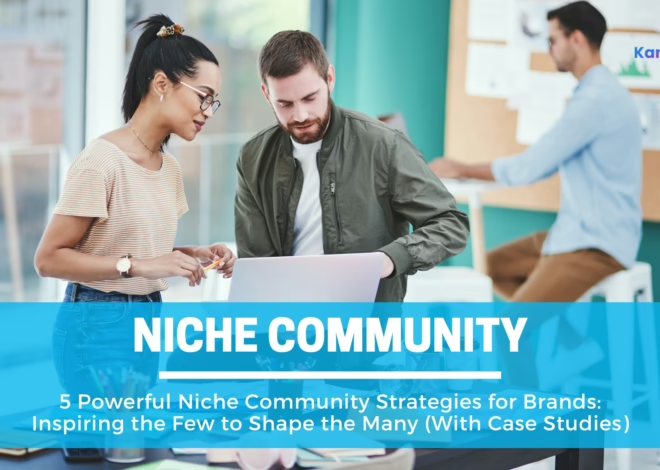
How to Build Community Trust: 7 Brilliant Ways to Drive Real Engagement
Why Trust Is the Heart of Every Thriving Community
Let’s be honest, people don’t stick around for logos, taglines, or fancy tech. They stay for trust and to build community trust means to drive real engagement.
Trust is what transforms a group of members into a living, breathing community. It fuels honesty, sparks collaboration, and builds the kind of emotional glue that keeps people coming back; not just for content or perks, but for connection.
But here’s the thing: you can’t buy trust. You have to build it. And if your goal is to build community that’s strong, inclusive, and sustainable you need to do it on purpose, not by accident.
When trust is missing, even the most well-designed spaces fall flat. But when it’s present, everything changes. Members become contributors. Conversations turn into relationships. A platform becomes a home. That’s why the strongest organizations, nonprofits, and learning environments invest early in trust; not just as a value, but as a design principle.
Think about the communities you’ve loved being part of, whether it’s a neighborhood group that checks in during power outages, a group of remote workers, or a nonprofit group that celebrates every small win. What made you feel like you belonged? What made you want to show up again? Chances are, trust was at the center of it all.
To build community that lasts, trust has to be more than a buzzword. It needs to be part of your foundation.
In this blog, we’ll walk you through 7 brilliant, proven ways to design for trust from Day 1 and keep it growing over time. These aren’t just tips; they’re timeless strategies to help you build community that feels like home.
Let’s Dive in!
1. Make Purpose Visible and Repeat It Often
A trustworthy community starts with a shared purpose. Why are you all here? What do you stand for? Who is this space meant to serve?
When members can clearly see the “why” behind your community, they’re more likely to show up with care, participate with intention, and bring others along.
In fact, to build community that truly endures, your purpose must act as both a north star and a rallying cry. It unites people across geographies, roles, and perspectives giving everyone something bigger than themselves to believe in.
Here’s how to reinforce your purpose to build community trust:
✔️ Pin a mission statement at the top of your forum, Slack, or platform
✔️ Add a short welcome video from a founder or moderator
✔️ Remind members of the purpose during events, updates, and newsletters
✔️ Make it a ritual, revisit the mission quarterly and invite member feedback
💡 Pro Tip: Visual storytelling matters. Purpose isn’t just what you say, it’s how you show it. Share stories, spotlight impact, and regularly answer: “How are we living our mission this month?”
🔶 Leading with Example: A nonprofit’s alumni network began every live event with a 30-second story about the community’s mission. Members said it kept them grounded and emotionally connected, especially during virtual meetups.
Over time, these small reminders compound. They create cultural memory. And with every repetition, you’re not just stating a mission, you’re building community around it.
2. Create Safe Spaces for Honest Expression
People don’t open up when they feel judged or ignored. They open up when they feel seen, respected, and safe.
To build community trust, you need to normalize vulnerability. And that starts with intentional safety, not silence.
To create space for honest expression, start with small moments of safety:
✔️ Moderate with kindness, enforce rules fairly and transparently
✔️ Welcome disagreement but not disrespect
✔️ Provide anonymous ways to give feedback
✔️ Set up private channels or small groups for sensitive discussions
These gestures signal to your members: “You matter here. Your voice counts.”
More Ways to Foster Safety:
- Appoint peer moderators who reflect your community’s diversity.
- Train hosts in trauma-informed communication.
- Offer opt-in “story circles” where members can speak freely with no recordings or judgment.
💡 Want to really get this right? Involve your members in setting the community guidelines. When people help shape the rules, they’re more likely to honor them.
And here’s the magic: once people feel safe expressing themselves, they begin to contribute in ways that surprise even themselves. That’s when your space shifts from passive to participatory. That’s how you build community where people trust not just the platform, but each other.

3. Deliver on Small Promises Every Time
Big promises don’t build trust. Kept promises do.
If you say “weekly updates,” send them. If you promise a Q&A, follow through. Even small gaps between what’s promised and what’s delivered can erode trust quickly especially in a digital space where people are used to being let down.
In fact, consistency is one of the most underrated tools when trying to build community that people can rely on. It’s not the size of the promise, but the dependability behind it that matters most.
✔️ Want to build momentum? Start by following through on micro-commitments:
▶ “We’ll post results next Friday”? Do it.
▶ “You’ll get a summary after the call”? Send it.
▶ “Poll results will guide the next meetup topic”? Show how they did.
🔶 Leading with Example: One student leadership group used automated reminders to ensure every poll, announcement, and reply went out on time. Their engagement rate tripled within 3 months because members could count on them.
💡 Small consistency creates big outcomes. Over time, it shapes expectations and builds psychological safety. People begin to think: “If they said it, they’ll do it.” And that’s the kind of dependability that helps build community loyalty.
Trust doesn’t grow from grand gestures. It grows from consistency.
4. Recognize People Publicly and Personally
One of the fastest ways to build community trust? Make people feel seen.
This doesn’t mean endless trophies. It means meaningful, timely, personalized appreciation:
✔️ A shoutout in a newsletter
✔️ A personal DM to say “we noticed your contribution”
✔️ A badge or status for milestone members
✔️ A “Member Spotlight” feature on your platform or social media
When you celebrate contributions big or small you signal that participation matters. Even quiet efforts deserve to be seen.
💡 Pro Tip: Recognition works best when it’s specific. “Thanks for your help” is nice. But “Thanks for starting that welcome thread, it helped 3 new members feel at home” is powerful.
Build peer-to-peer recognition:
Encourage members to nominate each other for kudos or spotlights. This adds a layer of shared appreciation and encourages community-driven visibility.
Recognition tells members: “You matter here.” And when members feel valued, they’re more likely to stay and invite others.
It’s one of the simplest, yet most powerful ways to build community where people show up not out of obligation, but out of belonging.
5. Show Behind-the-Scenes Transparency
Want people to trust your community leaders? Invite them behind the curtain.
Transparency is one of the best ways to build community trust especially when it’s about decision-making, challenges, and direction.
When members see how things work, they’re less likely to assume, doubt, or disconnect. Open dialogue builds mutual respect and reminds people that real humans are behind the screen, doing their best.
Here’s how to do it:
✔️ Host monthly “Ask Me Anything” sessions with your leadership team
✔️ Publish short updates: What’s working? What’s not? What’s next?
✔️ Share how decisions are made and who gets input
Want to go a step further? Include community members in advisory boards or planning groups. Transparency isn’t just telling, it’s also asking and involving.
🔶 Leading with Example: A parent advocacy group used simple “You Asked, We Acted” emails to show how member suggestions were being implemented. Members felt heard and participation surged.
This kind of authentic communication is foundational if you’re trying to build your community in a way that feels collaborative, not top-down. The more openly you share, the more members feel they’re part of something bigger, not just observers.
6. Empower Micro-Leadership Roles
Trust deepens when people feel like they have a role to play.
Empower members with small, meaningful leadership roles:
✔️ Welcome Champions: greet new members
✔️ Event Hosts: organize one conversation a month
✔️ Topic Leads: curate or moderate discussion in a category they love
✔️ Feedback Partners: run quarterly check-ins
When people are invited to lead, even in small ways, it signals that the community values their voice. These aren’t just tasks. They’re trust-builders.
This isn’t just about delegation, it’s about ownership. When members help shape the community, they’re more invested.
💡 Bonus: It reduces the burden on admins and staff, creating a healthier, more sustainable growth cycle.
Want to know how to build an online community that doesn’t just depend on one person? This is it. Micro-leadership spreads the effort, strengthens connections, and builds a culture of mutual support. When everyone has a chance to contribute, you don’t just build community, you build momentum.

7. Measure and Act on Member Sentiment
You can’t grow trust if you don’t know where it stands. Ask your members how they’re feeling then act on it.
A community isn’t just data, it’s people. And those people bring emotions, expectations, frustrations, and hopes. If you want to build community that truly resonates, you have to listen for what’s underneath the surface.
Here’s how to check the emotional “pulse” of your community:
✔️ Send quarterly pulse surveys
✔️ Track sentiment keywords in discussion threads (e.g., “frustrated,” “grateful”)
✔️ Follow up on feedback with real updates
✔️ Celebrate wins publicly and share what you’re working on behind the scenes
Don’t just collect feedback, close the loop. Let people know what you’ve learned, what changes are coming, and how they helped shape the outcome. That’s how trust grows: not just from asking, but from acting.
💡 Real Talk: Metrics like logins and likes only tell half the story. To truly build community that lasts, you need to measure what people feel, not just what they do.
🔶 Leading with Example: A volunteer-led initiative found that while activity seemed steady, their sentiment survey revealed rising confusion and fatigue. Based on that insight, they simplified their communication channels and added a weekly recap. Within a month, participation and morale saw a visible lift.
Insight-driven changes like these are how you build community intentionally not by guesswork, but by deep listening.
Where Kannect Comes In
It is totally understandable that everything mentioned above is easier said than done.
Building and maintaining trust, delivering consistent engagement, and truly listening to your members can quickly become overwhelming. Many communities start strong but falter because they lack the tools to build community efficiently and sustainably.
That’s exactly where platforms like Kannect come in.
Kannect is designed specifically for purpose-driven groups, nonprofits, associations, and organizations that want to build community trust and engagement at scale without burning out their team or juggling a dozen disconnected apps.
Here’s how Kannect helps you build community with intention, clarity, and ease:
✔️ Automated onboarding that sets the tone for new members right from their first login, helping them feel welcomed, informed, and ready to engage
✔️ Built-in direct messages, and alerts so you can deliver on your promises without extra manual work or missed opportunities
✔️ Powerful event hosting and RSVP tools that create consistency and boost participation by making event management seamless
✔️ Task Management feature that empower members with meaningful leadership responsibilities, amplifying their investment and ownership
✔️ Real-time tracking and analytics tools that let you understand how your community feels and respond quickly to concerns or ideas
💡 Bonus: You can manage your entire community easily from your phone or desktop without needing to learn coding or patch together six different software tools. This means your team can focus on building relationships, not troubleshooting tech.
For anyone wondering how to build a community that thrives, Kannect offers a comprehensive, all-in-one platform designed to reduce friction and amplify impact. By streamlining the hardest parts of community management, it lets you spend more time growing trust, encouraging meaningful participation, and achieving your mission.

Trust Signals That Actually Work: The 5-Point Community Trust Checklist
When it comes to build community, trust isn’t something you earn once and keep forever. It’s something you cultivate intentionally every day, in every interaction. Trust is fragile and must be nurtured continuously through consistent actions and genuine care.
But how do you know your digital space actually feels trustworthy to members? How can you tell if your efforts are truly helping to build community trust and engagement?
Use this 5-Point Community Trust Checklist to do a pulse-check on your community today. Bookmark it, share it with your team, or better yet ask your members directly to gather honest insights.
| Trust Signal | What to Look For | What to Do Next |
|---|---|---|
| ✔️ Clear Purpose | Do members know why the community exists and what’s in it for them? | Post a fresh mission statement as a pinned welcome post. Re-align all intro emails and onboarding content to emphasize this purpose. |
| ✔️ Visible Moderation | Do members feel protected from spam, trolls, and harmful content? | Share your community guidelines clearly and often. Highlight your moderator team’s presence and responsiveness. Use visual indicators for verified or trusted members to reassure newcomers. |
| ✔️ Consistent, Transparent Updates | Do members feel kept in the loop, even when things change? | Post regular “Here’s what’s happening” updates even if it’s to say “we’re working on it.” Silence kills trust, while transparency builds it. |
| ✔️ Two-Way Feedback | Do members feel heard, not just managed? | Add a monthly poll or open forum question: “What’s one thing we should change?” Make feedback visible, and credit or thank those who contribute. Act on the input to show it matters. |
| ✔️ Celebrated Members | Do your members feel seen and appreciated? | Spotlight contributions beyond just content creation. Use shout-outs, thank-you notes, and surprise personal messages to show genuine appreciation for participation and effort. |
Why This Checklist Matters in Your Efforts to Build Community
Trust isn’t a checkbox or a feature you can toggle on and off. It’s a result, the outcome of dozens of micro-moments where your community feels like it has a voice, a purpose, and a real seat at the table.
When these trust signals are strong, members engage more deeply, invite others naturally, and become long-term advocates. Conversely, ignoring these signs can slowly erode the foundation you’ve built.
If you want to build community that lasts, start with trust. Measure it, nurture it, and let it guide every decision you make.
💡 Pro Tip: Trust-building is a continuous journey, not a destination. Use this checklist quarterly to keep your finger on the pulse and remember, authentic trust comes from consistent, small actions that show you care.
Wrap-Up: Trust Is Built, Not Bought
Trust isn’t a feature. It’s a feeling. And it’s built in every DM, every decision, every interaction.
Whether it’s a quick reply to a member’s question, a transparent update during a challenging time, or a thoughtful recognition of someone’s contribution, these small moments add up to something powerful.
If your goal is to build community that’s resilient, responsive, and real you need to prioritize trust from Day 1.
Trust doesn’t grow overnight. It takes consistent care, intentional actions, and a genuine commitment to your members. It requires creating a space where people feel safe, seen, and valued every single day.
And yes, it takes a platform that supports you every step of the way, making it easier to manage communication, recognize members, gather feedback, and keep promises.
Ready to Build Community Trust and a Thriving Community?
Trust is the foundation of every thriving community and building it takes intention, consistency, and the right tools. Kannect helps you build community with purpose, making it easier to foster trust, keep members engaged, and create lasting connections.
👉 Start your free Kannect trial today and take the first step toward a community that feels like home.
✔️ Follow us on LinkedIn for fresh insights and practical tips to help you build community that lasts.
✔️ Subscribe to The Community Engagement Playbook – a smart, actionable read delivered once a week to build community with heart and impact.
Try Kannect today

FAQ: Building Community and How Kannect Supports You
1. How does Kannect help to build community effectively?
Kannect provides a unified platform that centralizes communication, event management, member engagement, and analytics. This helps community leaders deliver consistent experiences, track participation, and foster meaningful connections, making it easier to build community that thrives sustainably.
2. Can Kannect support communities of different sizes and types?
Yes! Kannect is designed to be flexible and scalable, whether you’re managing a small nonprofit group, a large alumni network, or a professional association. Its customizable features make it easy to tailor the platform to your unique community needs.
3. What are some simple ways to increase community trust quickly?
Start by setting clear expectations and guidelines, delivering consistent communication, and recognizing member contributions regularly. Small gestures like personalized welcomes and transparent updates go a long way in building trust.
4. Why is consistency important when trying to build community trust?
Consistency shows reliability and respect. When members know what to expect and see regular engagement from leadership, they feel safer and more valued, which encourages deeper participation.
5. How can I encourage members to contribute more actively?
Create multiple opportunities for participation, like polls, Q&A sessions, or challenges. Empower members with micro-leadership roles and celebrate their contributions to foster ownership.
6. What’s the biggest mistake to avoid when trying to build an online community?
Ignoring member feedback or failing to moderate discussions can quickly erode trust. It’s essential to listen, adapt, and maintain a respectful, inclusive environment.



